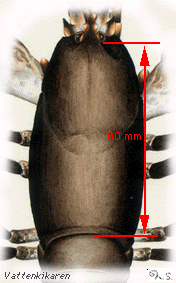|

Way
of life
|
|
How they reproduce
To reproduce requires at least 15°C
and that the sea water is not too brackish.
Breeding takes place in the late summer directly after they have slouged
and the female keeps the semen in a special container over the winter.
The following summer the eggs are layed and fertilized. During this process
the female lays on her back and the eggs are adhered between the tail
feet. The number of eggs can vary from between 5000-40000 depending on
the size of the female. The blue-black eggs are carried until they hatch
after about 10-12 months. The larvae,
about 7-8 mm large are pelagic during the first 14 days, during which
they slough their exoskeleton 3 times before falling to the bottom.
During this pelagic period, the young lobsters are easy prey for other
predators. When the young lobsters land on the bottom they search for
a hideaway to crawl into. Fish and crabs can became effective predators
when small lobsters are out looking for food at night.
When they became larger and older, natural mortality (caused by age, sickness
and so forth) is quite low. The natural mortality is approx. 6 % for lobsters
that have reached catch size, which can be compared to 20-30 % for most
specie of fish. These statistics imply that actions taken within the fishing
industry (like minimum size, capture of fertile egg-carrying females,
type of fishing equipment, etc) can be expected to be of significance
for the lobster population in the future.
Change colour
When you boil the lobster, it changes
colour. It has many different pigments. The most common of these pigments
are astaxantines, which belong to the chemical group carotenoids. The
pigment is chemically bonded to a protein. All these different pigments
together give the lobster a dark/black appearance. When the lobster is
boiled the heat sensitive proteins that bind the pigments are destroyed
(denaturated). The pigment alone has a red colour.
Misc.

The lobster is relatively stationary. Marked individuals have been caught
4-5 kilometres from where they were marked. Growth is slow and temperature
dependant. In the Skagerrak,
the males are sexually mature when they are about 16-17 cm in length and
the females at about 22-23 cm (approx. 350 g) in length. They are about
5-7 years old at this stage. The adults slough their exoskeleton once
or twice a year and increase 1-2 cm in size each time.
In Swedish waters lobsters are fished from the first Monday after the
20th of Septemmber until the end of May. Minimum size is 80 mm along the
escutcheon. Lobsters are fished with pots, baited with rotten and salted
fish that is cut up. Live lobsters are stored in lobster chests at different
depths depending on the water temperature until they are sold. Lobster
fisherman without licences are allowed up to 14 lobster pots and 6 crab
pots. Fishermen with licences have an allowed up to a maximum of 50 lobster
pots.
|

|
Page
2 of 2
|
|
|